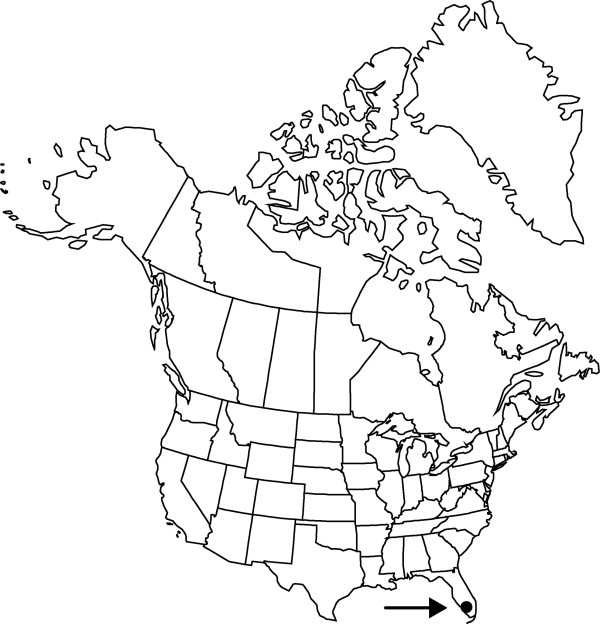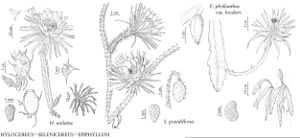Difference between revisions of "Epiphyllum phyllanthus var. hookeri"
Cact. Succ. J. (Los Angeles) 36: 113. 1964.
FNA>Volume Importer |
FNA>Volume Importer |
||
| Line 19: | Line 19: | ||
}}<!-- | }}<!-- | ||
| − | --><span class="statement" id="st- | + | --><span class="statement" id="st-undefined" data-properties=""><b>Shrubs,</b> to 200 cm, epiphytic. <b>Stem</b> segments light green, 40–120 × 6–9(–10) cm, margins obtusely serrate; areoles 3–8 cm apart along margins. <b>Spines</b> occasionally present in basal areoles, to 3 per areole, hairlike. <b>Flowers</b> salverform, 19–23 × 10–15(–16) cm; flower tube slender; outer tepals greenish white; inner tepals 8 × 0.5 cm. <b>Fruits</b> purplish red, typically 5-angled from the flower tube podaria, smooth between the ridges, oblong, 40–70 × 20–35 mm. <b>Seeds</b> 3.2–3.5 mm, minutely pitted.</span><!-- |
-->{{Treatment/Body | -->{{Treatment/Body | ||
| + | |phenology=Flowering spring–late summer. | ||
|habitat=Swamps, palmetto | |habitat=Swamps, palmetto | ||
|elevation=0-10 m | |elevation=0-10 m | ||
| Line 41: | Line 42: | ||
|basionyms=Epiphyllum hookeri | |basionyms=Epiphyllum hookeri | ||
|family=Cactaceae | |family=Cactaceae | ||
| + | |phenology=Flowering spring–late summer. | ||
|habitat=Swamps, palmetto | |habitat=Swamps, palmetto | ||
|elevation=0-10 m | |elevation=0-10 m | ||
|distribution=Fla.;s Mexico;West Indies;Central America;South America (n Venezuela);cultivated in tropical regions worldwide. | |distribution=Fla.;s Mexico;West Indies;Central America;South America (n Venezuela);cultivated in tropical regions worldwide. | ||
| + | |introduced=true | ||
|reference=None | |reference=None | ||
|publication title=Cact. Succ. J. (Los Angeles) | |publication title=Cact. Succ. J. (Los Angeles) | ||
|publication year=1964 | |publication year=1964 | ||
|special status= | |special status= | ||
| − | |source xml=https://jpend@bitbucket.org/aafc-mbb/fna- | + | |source xml=https://jpend@bitbucket.org/aafc-mbb/fna-data-curation.git/src/9216fc802291cd3df363fd52122300479582ede7/coarse_grained_fna_xml/V4/V4_342.xml |
|subfamily=Cactaceae subfam. Cactoideae | |subfamily=Cactaceae subfam. Cactoideae | ||
|genus=Epiphyllum | |genus=Epiphyllum | ||
|species=Epiphyllum phyllanthus | |species=Epiphyllum phyllanthus | ||
|variety=Epiphyllum phyllanthus var. hookeri | |variety=Epiphyllum phyllanthus var. hookeri | ||
| − | |||
| − | |||
| − | |||
| − | |||
| − | |||
| − | |||
| − | |||
| − | |||
| − | |||
| − | |||
| − | |||
| − | |||
| − | |||
| − | |||
| − | |||
| − | |||
| − | |||
| − | |||
| − | |||
| − | |||
| − | |||
| − | |||
| − | |||
| − | |||
| − | |||
| − | |||
| − | |||
}}<!-- | }}<!-- | ||
-->[[Category:Treatment]][[Category:Epiphyllum phyllanthus]] | -->[[Category:Treatment]][[Category:Epiphyllum phyllanthus]] | ||
Revision as of 14:06, 27 July 2019
Shrubs, to 200 cm, epiphytic. Stem segments light green, 40–120 × 6–9(–10) cm, margins obtusely serrate; areoles 3–8 cm apart along margins. Spines occasionally present in basal areoles, to 3 per areole, hairlike. Flowers salverform, 19–23 × 10–15(–16) cm; flower tube slender; outer tepals greenish white; inner tepals 8 × 0.5 cm. Fruits purplish red, typically 5-angled from the flower tube podaria, smooth between the ridges, oblong, 40–70 × 20–35 mm. Seeds 3.2–3.5 mm, minutely pitted.
Phenology: Flowering spring–late summer.
Habitat: Swamps, palmetto
Elevation: 0-10 m
Distribution

Fla., s Mexico, West Indies, Central America, South America (n Venezuela), cultivated in tropical regions worldwide.
Discussion
Epiphyllum phyllanthus var. hookeri was recently reported by A. N. Lima (1996) from Estero Island, Lee County, Florida, growing on Sabal palmetto. The variety also occurs in the swamp at Fakahatchee Strand, Collier County, Florida. The population biology of this species, as well as its long-term persistence in the flora, need to be monitored. Details of its pollination biology are not known.
Selected References
None.
